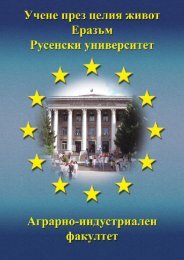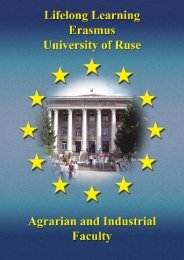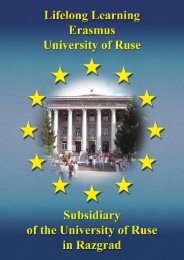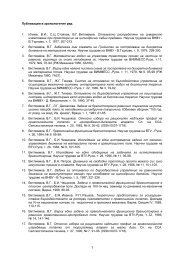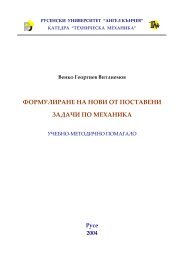Erasmus ECTS Information Package
Erasmus ECTS Information Package
Erasmus ECTS Information Package
You also want an ePaper? Increase the reach of your titles
YUMPU automatically turns print PDFs into web optimized ePapers that Google loves.
<strong>Erasmus</strong> <strong>ECTS</strong> <strong>Information</strong> <strong>Package</strong><br />
Faculty of EEEA<br />
3225 Television and Video Equipment<br />
<strong>ECTS</strong> credits: 5<br />
Weekly classes: 4lec+0sem+0labs+3ps<br />
Assessment: exam<br />
Type of exam: written and oral<br />
Departments involved:<br />
Department of Electronics<br />
Faculty of Electrical Engineering, Electronics and Automation<br />
Lecturers:<br />
Assoc. Prof. Valentin Angelov Mutkov, MEng, PhD, Dept. of Electronics,<br />
tel.: 888 246, Е-mail: vmutkov@ecs.uni-ruse.bg<br />
Abstract:<br />
The subject aims to give the students knowledge about the technical devices, the organization of the television<br />
systems and their subsystems: forming, keeping, transferring, reproducing and controlling the television signals.<br />
Course content:<br />
Television signals and systems. Analog-digital and digital-analog conversion. Source and channel coding for<br />
connection. Error protection by transferring the digital television signal. Characteristics of Digital Video<br />
Broadcasting signals. Transfer via air, cable and satellite distributing networks (DVB-T, DVB-S, DVB-C). General<br />
information about the digital modulations. Phase manipulation. Square amplitude modulation. OFDM. Modulation<br />
of type 8VSB. Television program transfer via MMDS. Video signal coding by standard MPEG-2. Profiles and<br />
levels. Digital video recording. Video taperecorders.<br />
Teaching and assessment:<br />
Lectures are delivered with a duration of two hours and four hours alternatingly every other week during the 8 th<br />
semester which continues for ten weeks. The practical exercises are held every week and last four hours. The<br />
measurements are made on specially developed laboratory models and television apparatuses. The course<br />
finishes with a written exam.<br />
3221 Electronic Security Equipment<br />
<strong>ECTS</strong> credits:3<br />
Workload per week: 3lec+0sem+0labs+2ps<br />
Assessment: continuous assessment<br />
Type of exam: written<br />
Departments involved:<br />
Department of Electronics<br />
Faculty of Electrical Engineering, Electronics and Automation<br />
Lecturers:<br />
Assoc. Prof. Valentin Yordanov Dimov, MEng, PhD, Dept of Electronics,<br />
tel.: 888 772, E-mail: vdimov@ecs.uni-ruse.bg<br />
Abstract:<br />
The compulsory course helps students to gather theoretical knowledge about the basics, working methods and<br />
types of electronic security equipment and to obtain practical skills to use it. The main learning tasks are the study<br />
of specific components and devices used for alarm, security and protection of different objects and bringing in<br />
mind techniques for analysis and design of electronic security equipment.<br />
Course content:<br />
Introduction to electronic security equipment. Distance operating security systems. Detecting units in electronic<br />
security systems. Alarm transmission devices and indicators. Access control systems and devices. TV monitoring<br />
control systems. Car alarm systems. Fire alarm electronic devices. Fire prevention electronic systems.<br />
Teaching and assessment:<br />
This subject is taught during the last semester the duration of which is 10 weeks. The lectures are 3 hours per<br />
week. Visual aids are used such as presentation boards, charts, diagrams, etc. The students regularly get<br />
consultations on the learning material. The practical exercises are 3 hours per week. They are conducted together<br />
with the lecture material.<br />
The final mark is formed on the basis of the marks from the tests. If the mark is not satisfactory, then the student<br />
sits for a written exam, which includes two questions from the course prospectus.<br />
108



